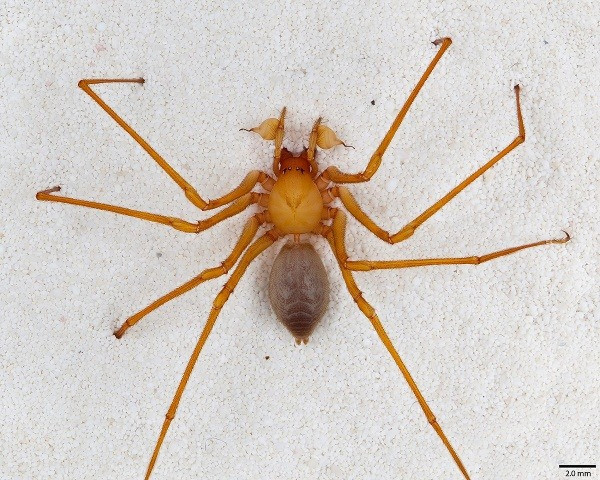Beware The 'Cave Robber': New Spider With Velociraptor-Like Claws Found In Oregon

A mysterious organism has been found lurking in the caves and forests of the Pacific Northwest. No, it's not a sasquatch - it's a six-eyed spider with curved, vicious-looking claws that scientists have dubbed Trogloraptor, or "cave robber."
In a paper published in the journal Zookeys on Friday, scientists from the arachnology lab at the California Academy of Sciences described the new critter, which is about the size of a half-dollar coin and likes to hang from simple webs on the ceilings of caves. Researchers and citizen scientist have found Trogloraptor in old-growth redwood forests and in caves across Oregon and California.
It has curved claws that are part Velociraptor and part fine-toothed comb - appendages that suggest a specialized kind of hunting strategy, but the details aren't yet clear, according to the authors.
Trogloraptor marchingtoni is not just a new species and genus; it's also the first member of a completely new family of spiders that researchers are calling Trogloraptoridae. Based on the structure of its genitalia and silk-spinning organs, the researchers think it's closely related to the superfamily Dysderoidea, which contains four families of spiders - including the Oonopidae, or "goblin spiders" - characterized by pinching fangs and six eyes instead of the classical eight.
What's remarkable is that while scientists and citizens have found at least 3,700 species of spider in North America, "there are still surprises in store in this well-known region, especially in remote or inaccessible places, such as caves," the authors wrote.
Trogloraptor isn't the first new spider that's been found thanks to the help of amateurs. Photographer and vineyard worker Stuart Harris snapped a picture of a tiny jumping spider in an Australian national park. The photo caught the attention of spider experts when Harris posted it to his Flickr account, and it was soon pegged as a new kind of peacock spider. The spider was named Maratus harrisi in Harris' honor.
In 2011, another Australian man found an oddly colored trapdoor spider with a brilliant white head. The man sent it to the Western Australian Museum.
"I nearly fell over when I saw its white head," museum senior curator Mark Harvey told National Geographic last November.
Now that Trogloraptor has been identified, the real work begins: arachnologists will study the new spider's behavior more closely - and keep an eye out for any undiscovered sister species.
"If such a large and bizarre spider could have gone undetected for so long, who knows what else may lurk undiscovered in this remarkable part of the world," the authors wrote.
SOURCE: Griswold et al. "An extraordinary new family of spiders from caves in the Pacific Northwest (Araneae, Trogloraptoridae, new family)." ZooKeys 215: 77-102, 17 August 2012.
© Copyright IBTimes 2025. All rights reserved.




















